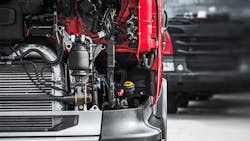We’ve heard plenty of talk about the microchip shortage which initially affected vehicle production, but now is being felt on the maintenance and repair side. The materials shortage has now extended beyond just microchips to include things like steel, wiring harnesses, aluminum, the list goes on.
Lead times on new vehicle production are being stretched to the point of breaking and delivery dates for new vehicles are getting pushed out further and further.
So, what does this mean to fleets? It looks like many of you may have to hang on to assets you had hoped to retire for a bit longer than planned. There are a couple of things you can try:
- Perform a health check on all assets: Determine the condition of each tractor and trailer you own. You will find that some are really “bad actors” and aren’t worth your time and money trying to get them in better shape to last for another 12 to 18 months. But you may happily discover that with a little TLC some of your vehicles will be able to go that extra mile (or 100,000 miles) while you wait for new vehicles to be delivered.
- Look at a different make of vehicle: Fortunately, or unfortunately depending on your point of view, the shortage is agnostic—all manufacturers are suffering equally. However, the supply of trucks on the ground and availability vary by manufacturer and dealer location. You may not find exactly the truck you are looking for on the dealer’s lot, but you might find something that comes close that will serve you well for a few years.
- Rationalize your assets across your network: Take time to look at the utilization of every asset at every location. Are some assets being underutilized while others are racking up extra miles? If so, can you switch trucks between locations to get more utilization balance across all your locations? That may mean some locations will actually end up with fewer trucks while others may gain a new truck or two. The goal is to look across all your locations and do what is best for the enterprise overall.
- Stay on top of maintenance: This is no time to skimp on or skip preventive maintenance service. Make sure you are tracking PM compliance to ensure all vehicles are getting into the shop for their needed service. Well-maintained assets tend to last longer and have a better TCO.
- Don’t lose sight of your strategic purchase plan: If this shortage is like any of the others we have lived through in the past, it will end, and we will return to more normal vehicle production levels. There is no need to make wholesale changes in your asset purchase plan. Yes, you may need to hang onto some assets for a bit longer, but that does not mean that you should swap out half your fleet when things are back to normal.
We’ve been through a lot of crazy times in trucking—remember the pre-buys leading up to all the emissions changes—and we’ve always come out okay. We will weather this latest storm as well if we stay focused and take some practical steps to make the best use of the assets we have and ensure they are in the best condition possible.
Gino Fontana, CTP, is COO and EVP at Transervice Logistics Inc. Prior to this recent promotion, he was VP of operations at Berkeley Division and Puerto Rico. His operational expertise emphasizes cost savings, process efficiency and improvement, superior quality, and people management skills. He has more than 35 years of experience in the transportation and logistics industry with both operational and sales experience.
About the Author
Gino Fontana
Chief operating officer and executive vice president at Transervice Logistics Inc.
Gino Fontana, CTP, is COO and EVP at Transervice Logistics Inc. His operational expertise emphasizes cost savings, process efficiency and improvement, superior quality, and people management skills. He has more than 35 years of experience in the transportation and logistics industry with both operational and sales experience.
